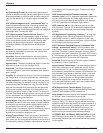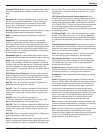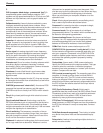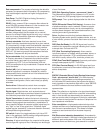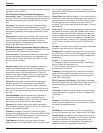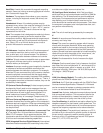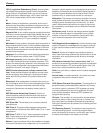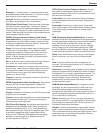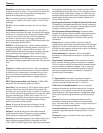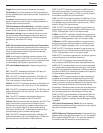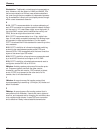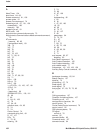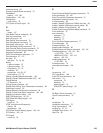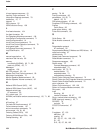
MultiModemISI Hybrid Series, ISIHI-2S 177
Glossary
P
Parameter: 1. A “place holder” in a command that should
be substituted with useful information. 2. The list of accept-
able values for a given option or command.
Parity bit: An extra bit attached to each byte of synchro-
nous data used to detect errors in transmission.
PCB (Printed Circuit Board): A flat board that holds chips
and other electronic components. The board is “printed”
with electrically conductive pathways between components.
The main PCB in a system is called a motherboard and the
smaller PCBs that plug into the slots in the motherboard are
called daughter boards or cards.
PCMCIA (Personal Computer Memory Card Interna-
tional Association): An organization of U.S. and Japanese
companies set up to standardize memory cards and other
architecture-independent expansion devices. These cards
are typically used in laptop computers.
Phase: The timing of a signal based upon the starting point
of each cycle in another signal. To be detected, phase
requires the comparing of two signals. If the cycle of two
signals begin at the same point, they are said to be “in-
phase”. In-phase signals add, while out-of-phase signals
tend to cancel each other.
Port: A location for input or output data exchange. Comput-
ers, muxes, etc., have ports for various purposes.
Print Server: A computer in a network that controls one or
more printers. It stores the print image output from all users
of the system and feeds it to the printer one job at a time.
The print server may be part of the network operating
system or an add-on utility.
Program: A collection of computer instructions that tell the
computer what to do.
PROM (Programmable Read Only Memory): A permanent
memory chip that can be programmed or filled by the
customer after the manufacturer has set initial values.
Contrast with ROM.
Prompt: A request for information from the PC that provides
required input or information.
Protocol: A set of rules that defines how computing devices
communicate with each other. The rules governing the
transmitting and receiving of data.
PSK (Phase Shift Keying): A modulation technique which
establishes two-bit elements, called “dibits” yielding four
possible combinations: 00,01,10,11. These element are
then represented by 90, 180 and 270 degree angles. PSK
produces the appropriate shift in phase relative to the
original carrier. Differential PSK replaces this technology
because it is less prone to error. Modems using PSK
normally operate at 1200 bps.
PSTN (Public Switched Telephone Network): A world-
wide public voice telephone network that is used as a
telecommunications medium for the transmission of voice,
data and other information.
Pulse dialing: One of two methods of dialing a telephone,
usually associated with rotary dial phones. Compare with
tone dialing.
Pulse-width: Pertaining to a digital signal. Pulse width
refers to the duration of one state between clocking signals.
Pulse width roughly corresponds to an analog signal’s
wavelength.
Q
QAM (Quadrature Amplitude Modulation): A complex
method of modulation that establishes twelve phase angles
and four amplitudes, designating sixteen possible combina-
tions. QAM encodes hexadecimal values (also called
quadbits) into one cycle of the carrier. Using a 1800 bps
carrier frequency and a 2400 baud signaling rate, QAM
provides a 9600 bps modulation speed. However, because
it uses amplitude modulation, QAM is susceptible to noise.
Queue: A set of activities that are waiting in chronological
order for an action, such as printing, to be performed.
R
Rack: A frame or cabinet into which components are
mounted. The industry standard rack is 19” wide and has
variable depth and height.
Rackmount: A packaging style available for many types of
electronic equipment which enables the installer to mount
the equipment in an industry standardized enclosure. The
rackmount equipment is fitted with brackets, rather than
being packages in its own enclosure. Rackmounting
conserves disk and floor space (real estate) and often
conserves power outlets.
RAM (Random Access Memory): A computer’s primary
workspace. All data must be stored in RAM (even for a
short while) before software can use the processor to
manipulate the data. Before a PC can do anything useful, it
must move programs from disk to RAM. When you turn it
off, all information in RAM is lost.
Reboot: Restarting your PC by turning off the power and
then turning it back on, or by pressing Alt,Ctrl and Del keys
at the same time. Warm boot=Ctrl+Alt+Del (soft boot) or
Cold boot=Power switch (hard boot).
Repeater: A device that amplifies or regenerates the data
signal in order to extend the distance of the transmission.
This can be used with both analog and digital signals, and is
used extensively in long distance transmission to keep
signals from losing their strength.




